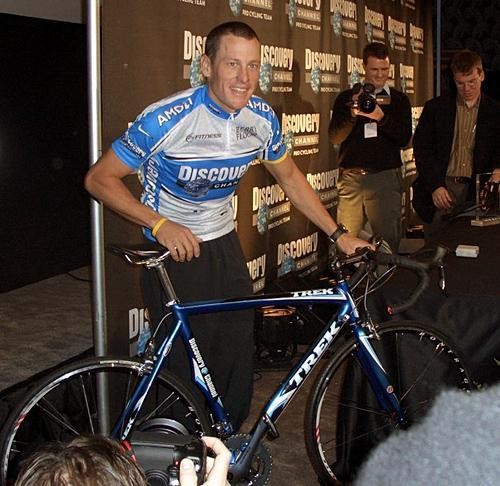Armstrong's 'F-One' group plots the hour
More details have leaked out about the supposed preparations underway for Lance Armstrong to have a...

More details have leaked out about the supposed preparations underway for Lance Armstrong to have a crack at the world hour record at some stage this year.
While it is yet to be confirmed, in our report from the Discovery Channel cycling team training camp (see report), Armstrong discussed 'the hour' and appeared to serious about making an attempt.
A recent story in the New York Times outlined the "F-One" group, an assembly of experts and equipment companies formed in 2003 who may collaborate on the attempts. The paper said the group includes Carmichael Training Systems (CTS), Nike, helmet-maker Giro, wheelmaker Hed, Advanced Micro Devices and aerodynamicist Len Brownlie. Bicycle manufacturer Trek and wheelmaker Bontrager are also mainstays of the F-One group.
At the Silver Springs team presentation, Armstrong said to Cyclingnews, "(The Hour Record) has become a serious consideration and I actually have in my possession the very first version of the track that I've been trying to do some testing on. (The Hour) is something that fascinates me; Johan and I have not really sat down and talked a lot about it, you know, what it takes to do it, where it fits in in the year, which I think is one of the trickiest things. I spent a lot of time talking to Chris Carmichael and his team (at CTS) about it and the proper approach."
Altitude or not?
"I think the trick with the Hour Record is where you do it," Armstrong explained. "Obviously we can do it in Manchester where it's been done several times. Ideally we would look for a high-altitude location and as we all know, there are not that many covered velodromes at altitude, so then you're at the mercy of the winds and the elements outside, or the temperature if it's not exactly in the summertime.
"We want to do it at altitude and it's just a question of where we go, what we find and if we build a velodrome to do it, and then take the velodrome down. And I think that's probably the most likely scenario as of today: Do we want to cover Colorado Springs and resurface it, or do go to Salt Lake City or somewhere like that and build a new velodrome?"
Get The Leadout Newsletter
The latest race content, interviews, features, reviews and expert buying guides, direct to your inbox!
A presentation at the meeting of the F-One group, according to the NYT, was made by Jay Kearney, from CTS, who discussed the variables of making the attempt at altitude or sea level. While riding at altitude has lower air resistance, there is also less oxygen for the athlete. Meanwhile, even factors such as a crowded velodrome - and it's understood that Armstrong would make the attempt in the USA - can increase the carbon dioxide in the atmosphere, again, reducing performance.
Morris Denton, a marketing executive from AMD, the microelectronics giant and one of the Discovery team's supporting sponsors, told the NYT: "I think it would be an amazing spectacle. If you look at the crowds Lance draws in the United States and you think about what would happen if you put some kind of marketing effort behind this event, it would be immenses."
At the same presentation, the president of Capital Sports and Entertainment, the sports management company that looks after Armstrong, said to the paper, "right now it's an idea. It's a four-minute mile kind of thing, but we don't have it on the calendar yet."
The current "absolute" hour record stands at 49.441km set by Chris Boardman on October 27, 2000, at a special session of the 2000 Track Cycling World Championships in Manchester, UK (see report). This "Absolute" record, as defined by the UCI, was set at near-sea level in the British city. The UCI has strict requirements on the technology that can be used, designed to resemble the type of bicycle that Eddy Merckx used when he set the 'hour' at 49.43915 km in Mexico City (at over 2400m altitude) on October 25, 1972.
While Boardman only marginally bettered Merckx's record by 10 metres, it was set at a much lower altitude and while difficult to quantify in terms of distance covered, the reduced air resistance of riding at altitude is considered a significant factor. (For example, all track cycling records now take altitude into account, with separate times for records above and below 1000m.)
Merckx's record stood for 12 years until Francesco Moser used more aerodynamic equipment in 1984 (also at Mexico City's velodrome) to record a 50.80842km distance.
But Boardman also holds the record for what the UCI now calls the "best hour performance", where he used the latest in bicycle technology and aerodynamics to cover a staggering 56.375km in an hour in 1996. Boardman's then record was the latest in a staggering demolition of this record in the period from 1993-96, where Scotsman Graeme Obree, Moser, Miguel Indurain and Tony Rominger all smashed the record, until Boardman's remaining record was set in 1996.
The formation of the F-One group would indicate that Armstrong may be looking seriously at both records, as much of the technology for the "Absolute" record is quite standard, as it's intended to reflect pure athletic performance.